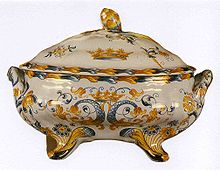Terrine
In German, a terrine is a soup bowl with a lid that was added to tableware in the 18th century . Later mostly made of porcelain , sometimes also made of silver . In French, on the other hand , la terrine means an earthen bowl for preparing and serving meat dishes, v. a. For pies that are prepared without dough (bowl or bowl pies ) such as B. Goose liver and poultry pâtés. Terrine not only describes the stoneware shape , but also its content. A terrine du chef is therefore a house-style pie and not a soup. In French, the German soup bowl corresponds to the soupière and the queen pate , which is not served in a terrine but in a round puff pastry form , is called vol-au-vent or bouchée à la Reine.
Soups and rustic dishes are traditionally often served in smaller tureens as a single portion. The classic lion's head terrine made of white porcelain is particularly widespread in the catering trade , which is offered by tableware manufacturers and in catering supplies mostly in different sizes from the small mini terrine to the large soup tureen. The lion head motif goes back to Heinrich I , who after his marriage to Adelheid von Löwen in 1121 integrated part of her family coat of arms into his royal banner and had a bowl made of pure gold with the coat of arms of his wife for the festivities. Around 600 years later, the royal porcelain manufactory in Limoges, France, took over the tradition of this lion's head and equipped part of the lordly porcelain with the same image of lions from Britain.
Web links
Individual evidence
- ↑ The best piece: Delicacy with a story . In: fleischwirtschaft.de . ( fleischwirtschaft.de [accessed on November 16, 2018]).

